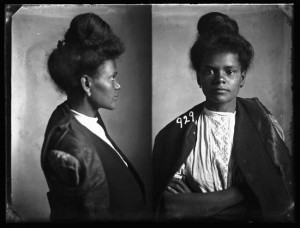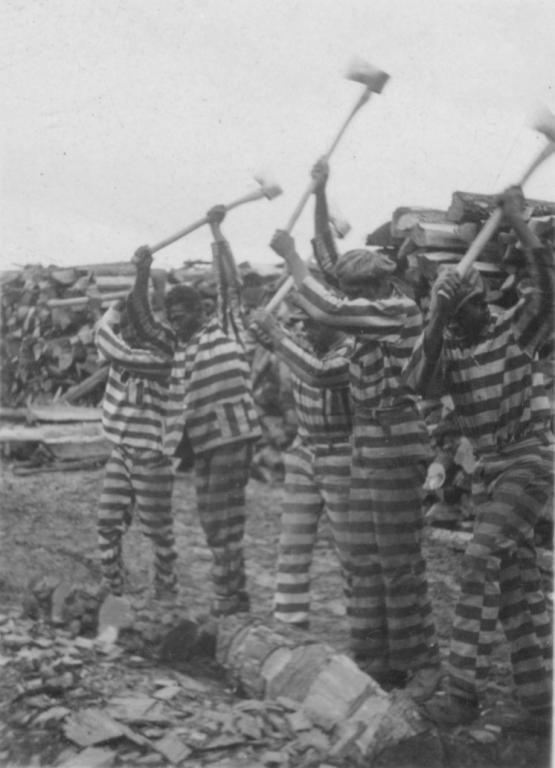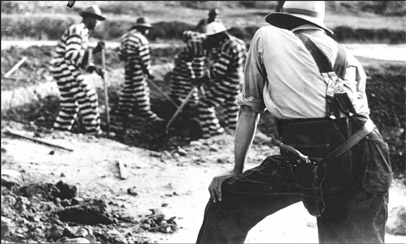Matthew J. Mancini. One Dies, Get Another: Convict Leasing in the American South, 1866-1928. Columbia, S.C.: University of South Carolina Press, 1996.











From H-Net, a book review by Garland Brinkley of the Department of Economics, School of Public Health at the University of California-Berkeley, on October, 1999 -- Several economic historians have asserted that African-Americans were better off in the aftermath of the Civil War. Ransom and Sutch's (1977) classic leisure for labor trade-off, for example, suggests that freedmen worked fewer hours and fewer days and that fewer members of the family spent time in the fields after the Civil War with the resultant higher utility (but lower income). What are noticeably absent from previous histories of the South, was the continuation of slavery under the even more brutal conditions driven by economic incentives. While most believe that the thirteenth Amendment abolished slavery and involuntary servitude, a loophole was opened that resulted in the widespread continuation of slavery in the Southern states of America -- slavery as punishment for a crime. According to the thirteenth amendment, "Neither slavery nor involuntary servitude, except as punishment for crime whereof the party shall have been duly convicted, shall exist within the United States, or any place subject to their jurisdiction." Matthew Mancini documents the widespread nature of post-civil war slavery in every state that composed the Confederacy except Virginia. His book is divided into three parts: part one addresses the convergence of forces (economic, racial, and political) that began the convict labor system and perpetuated the convict labor system; part two details the particular manifestation of the convict labor system in each southern state; and, part three explains the demise of the system that maintained African-Americans in slavery for a half century after the surrender by Lee at Appomattox.

This book details the darker side of our discipline when economic incentives prevail over simple humanity. Economically, when an asset is replaceable at no cost, money spent upon maintenance costs will lower profits. When the assets are human beings, duly convicted of (in many cases) racially motivated trumped up charges and obtained at low cost and through political machinations, the incentive is to work them as hard as possible and to spend little on food, shelter, clothing, medical care, etc., in order to maximize profits.

Georgia practiced the most undiluted and typical form of convict leasing of any of the southern states. However, political favoritism determined the issuance and bid price of convict leasing contracts and political pressures ensured no interference in the working and living conditions of the convicts. Average prison sentences lengthened dramatically during this period. Convicts were invariably leased to prominent and wealthy Georgian families who worked them on railroads and in coal mining. Even though reformers exposed the brutalities of the system in Georgia, the demise of convict labor in Georgia came about due to political reform and market forces when the bids that contractors had to pay for convict labor finally became equal to free wage rates.
Alabama used the convict labor system as an enormously successful revenue generating mechanism. Not only did convict leasing last longer in Alabama than in any other southern state, but it was also notable due to the extreme quantity of convicts in the system. Convict leasing began in Alabama in 1846 and lasted until July 1, 1928 when Herbert Hoover was vying for the White House. In 1883, 10 percent of Alabama's total revenue was derived form convict leasing while in 1898, 73 percent of total revenue came from this same source. Death rates among leased convicts were approximately ten times the death rates of prisoners in non-lease states. In 1873, for example, 25 percent of all black leased convicts died. Possibly the greatest impetus to the continuance of convict labor in Alabama was to depress the union movement.

Arkansas was notorious for the brutality of its convict leasing system resulting from the lack of official monitoring of convict laborers. Economically different from other southern states, Arkansas actually paid companies to work their prisoners for much of the time the system was in place. Arkansas' system of convict leasing was also quite political in terms of issuance of contracts and oversight or lack of oversight of convicts. No state official was empowered to oversee the plight of the prisoners and businesses had complete autonomy in the disposition and working conditions of convict laborers. Mines and plantations that used convict laborers commonly had secret graveyards containing the bodies of prisoners who had been beaten and/or tortured to death. Convicts would be made to fight each other, sometimes to the death, for the amusement of the guards and wardens.

Both Mississippi and Louisiana are extremely similar in terms of lack of oversight of their convict leasing population, almost exclusive use of convict leasing on agricultural plantations, and failure of the state to recoup any revenue from the system. Mississippi was noted as having epidemic death rates without an epidemic. Louisiana institutions seemed to be unable to distinguish between the terms 'slave,' 'Negro,' 'convict,' and 'farm work'. The lessees generally did not pay the full amount of the contract price to the state and usually paid nothing. Convicts were generally among the black population. For example, in Louisiana, a black social group consisting of thirty-eight members were convicted in a mock trial and sent to prison for contract labor.

Tennessee convict leasing lasted from 1871 to 1896 and was bitterly opposed by free miners from the beginning. The conflict between the huge Tennessee Coal, Iron, and Railway Company (TCI) and mining population was characterized by violence. This conflict resulted from the wage rate of the miners falling from $1.25 per ton of coal before convict leasing to just $0.50 wherever convict leasing was implemented. TCI admitted that the main reason it used convict labor was to break strikes and undermine union formation.

Texas, Florida, and the Carolinas each had their own unique features and economic issues with contract leasing of convicts. However, all were economically motivated and all were brutal, life shortening, and profitable for the lessees. Rarely did the state actually receive revenue but generally they did not experience a drain on the treasury. Texas convicts were concentrated mostly in sugar plantations, Florida's and the Carolinas' convicts were almost exclusively involved in railway building. Later in the century, the Carolinas shifted into state farms and county roads and out of railway building. Unlike the other southern states, only half of Texas inmates were black. However, the African-American convicts went to the sugar plantations while the white and Latino population were sent to less harsh and hazardous work.

The convict labor leasing system came about mostly after the Civil War and in earnest after reconstruction due to the economic realities. The Southern States were generally broke and could not afford either the cost of building or maintaining prisons. The economic but morally weak and incorrect solution was to use convicts as a source of revenue or, at least, to prevent them from draining the fragile financial positions of the states. The abolition of the system was also motivated mostly by economic realities. While reformers brought the shocking truths and abuses of this notorious system before the eyes of the world, the real truth is far different. In every state, the evils of convict labor and abuses were in newspapers and journals within two years of implementation and were generally repeated during every election cycle. Mostly due to political reform, the process whereby convicts were obtained became market oriented. As a result, the costs to businesses rose until convict labor was comparable to free labor. Monopoly profits derived from rent seeking behavior no longer accrued to private firms ending the economic incentives of maintaining convict leasing. The convict leasing system was not abolished but merely transformed. Prisoners who labored for private companies and businesses increasing their profits now labored for the public sector. The chain gang replaced plantation labor. There was in truth little change in the lives of convicts themselves since life was still short and brutal but rather change occurred in the flow and distribution of money that spelled an end to the forced labor of postbellum "slaves."

This book is necessary for any serious student of the history of the postbellum South or any advocate of unfettered capitalism. The lessons to be drawn from this study can be applied to many of the policies proposed by the IMF or the World Bank fostered upon third world nations. While the circumstances surrounding the convict labor system in the aftermath of the Civil War can be considered unique, economic incentives and economic realities are unchanging and repeats of convict labor leasing are widespread today. (source: H-Net,)

GOT DAM AMERICA FROM ITS FOUNDATION TO ITS TOTAL DESTRUCTION.
ReplyDelete